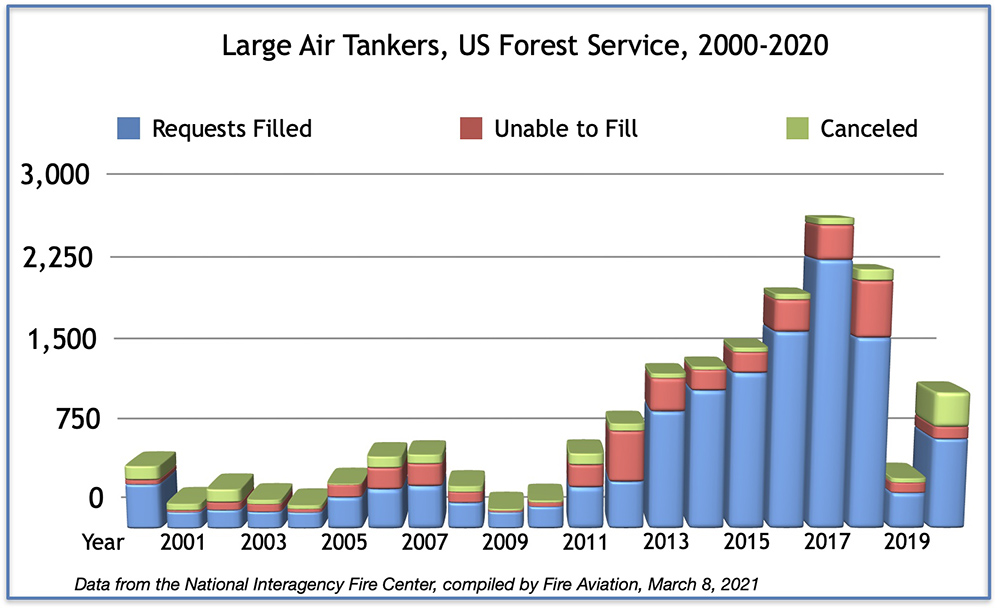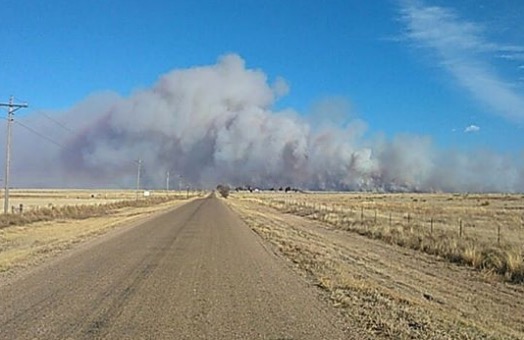
-This article was first published on Fire Aviation-
In fiscal year 2018 the U.S. Forest Service spent more than half a billion dollars, $507,000,000, on air tankers, helicopters and other firefighting aircraft.
The agency’s spending on aircraft contracts, support, and fire suppression operations has gone on for decades with little meaningful oversight. The Forest Service has been repeatedly asked to justify the expense by the Government Accountability Office, the Department of Agriculture’s Inspector General, and Senators and Representatives in committee hearings — “How do you know air tankers are effective?”
A report by the GAO in August, 2013 said, “None of the agencies’ studies and strategy documents contained information on aircraft performance and effectiveness in supporting firefighting operations, which limits the agencies’ understanding of the strengths and limitations of each type of firefighting aircraft and their abilities to identify the number and type of aircraft they need,”
The Inspector General’s investigation concluded, “[The Forest Service] has not used aviation firefighting performance measures that directly demonstrate cost-impact…”
In 2012 the Forest Service began the Aerial Firefighting Use and Effectiveness (AFUE) study to address those concerns. After nine years and an annual cost of $1.3 million plus overtime for the field data collectors, a report about the study was quietly released August 20, 2020 during the peak of an exceptionally busy wildland fire season.
The AFUE had very ambitious goals initially when Tom Harbour was the Director of Fire and Aviation for the U.S. Forest Service.
“AFUE was initially intended to eventually help answer questions about the size and composition of aviation assets needed by the USFS,” Mr. Harbour told Fire Aviation recently.
From the agency’s AFUE website:
The desired outcome is to support training, mission selection and execution, and overall aerial fleet planning to enhance effectiveness and cost-effectiveness, potentially reducing aviation and fire suppression costs by answering a general, but complex question: “What are the best mixes of aircraft to do any fire suppression job?”
The data in the study was collected by four crews, or modules, of three to four single resource qualified firefighters, each with 10 to 25 years of firefighting experience. The modules mapped aerial drop activity and recorded incident objectives, outcomes, and conditions for aerial suppression actions that supported tactical and strategic incident objectives. The module coordinator coordinated crew movements.
AFUE personnel applied analysis protocols to data after observing 27,611 drops from 2015 to 2018 at incident locations throughout the USA in 18 States and across all nine Forest Service regions.
Other studies
This was not the first time that a study took on the task of determining the aircraft mix needed to assist wildland firefighters in the United States or to evaluate aerially applied fire retardant. The Inspector General’s report listed seven, most of which are on the Wildfire Today Documents page.
- 1995, National Study of Airtankers to Support Initial Attack and Large Fire Suppression: Final Report Phase 1, recommended 41 large air tankers.
- 1996, National Study of (Large) Airtankers to Support Initial Attack and Large Fire Suppression: Final Report Phase 2, recommended 41 large air tankers.
2005, Wildland Fire Management Aerial Application Study, recommended 34-41 large air tankers. - 2008, Management Efficiency Assessment on Aviation Activities in the USDA Forest Service, recommended 19 large air tankers.
- 2009, National Interagency Aviation Council Interagency Aviation Strategy, recommended 32 large air tankers, 3 water scoopers, 35 single engine air tankers, 34 large helicopters, 47 medium helicopters, and 100 small helicopters.
- 2012, Air Attack Against Wildfires: Understanding U.S. Forest Service Requirements for Large Aircraft, Rand, recommended 1-9 large air tankers, 14-55 water scoopers, and 0-7 large helicopters.
- 2012, Firefighting Aircraft Study, AVID LLC, recommended 35 large air tankers.
Additional studies not mentioned in the Inspector General’s report:
- 1984, Project Aquarius was designed to test the effectiveness of large aircraft in controlling bushfires in Australia by dropping water and fire retardants, but also to research the nature of wildfire, its effects on the bush and the firefighters, and the most effective forms of fire control. It was not fully completed.
- 1985, Operational Retardant Evaluation, USFS.
- 2007, The Effectiveness and Efficiency of Aerial Firefighting in Australia, Bushfire Cooperative Research Centre.

Which fires were analyzed in the AFUE study?
The fires at which data was collected were primarily large that escaped initial attack, since it takes time to mobilize the modules. Smaller fires that were stopped by ground and air resources are likely underrepresented; that is, fires on which aircraft were most effective may not show up in the data. Fires burning during high or extreme fire danger that grew large because of the burning conditions may be overrepresented. As conditions become extreme, firefighting aircraft are less effective.
From the study:
[T]he sample may be biased towards incidents with substantial aircraft activity and especially those with any airtanker activity. Because AFUE was launched primarily to evaluate large and very large airtankers, choices were consistently made to observe fires with airtanker activity. Recognizing that many fires that receive any airtanker drops typically only receive a few drops, the sample could be underrepresenting fires with limited airtanker activity. Further, many aerial firefighting drops occur on remote fires that make direct observation challenging.
What were the findings of the AFUE?
Much of the AFUE report is based on two performance measures that the study used to determine the effectiveness of an aircraft, Interaction Percentage (IP) and Probability of Success (POS). IP, a term apparently invented, is defined as the proportion of drops that interacted with fire. POS is the number of effective drops divided by the total number of drops with known and interacting outcomes.

The interaction percentage data compares apples and oranges. Helicopters and scoopers primarily drop water, while fixed wing tankers that are not scoopers almost always drop long term fire retardant. Since water is a very short term fire retarding agent, it is usually dropped directly on the flaming front. If it were dropped out ahead of the fire, much of it would run off the fuel, soak into the ground, or evaporate before the fire reached that location.
Long term fire retardant dropped by air tankers is usually placed ahead of the fire. It might be dozens of feet away, or when pretreating a ridgeline, protecting a point, or securing a planned indirect fireline it could be thousands of feet away from the flaming front. Retardant, much more viscous than water, adheres to the vegetation more so than water, retains moisture for a while, and can even interfere with the process of combustion after it dries.
Therefore, comparing the interactions of water dropping and retardant dropping aircraft is not a reasonable exercise. Water droppers should always be very close to 100 percent on the interaction scale, while retardant droppers will have lower numbers, in part because some of the drops are done to support indirect firelines or ignition operations that did not interact with the main fire.

The chart which shows small Type 3 helicopters having 100 percent interaction does not mean that dropping 100 gallons of water is going to have a larger overall fire-slowing result than a 75 percent interaction DC-10 very large air tanker dropping 94 times as much liquid.
The interaction rates of single engine, large, and very large air tankers all range from about 74 percent to 80 percent. And in the helicopter category, it is about 87 percent to 100, with the small 100-gallon Type 3 having the highest number. The largest Type 1 helicopters carry 2,500 to 3,000 gallons; their interaction percentage is about 10 points higher than the average retardant dropping air tanker.

The study also rates the aircraft on the probability of success, only taking into account drops that actually interacted with the fire. When used on a large fire the helicopters averaged about 0.73 and the retardant dropping air tankers, about 0.72. If excluding the small Type 3 helicopters which are not often used to drop water on large fires, the helicopter average increases to about 0.84
What did the AFUE study recommend?
Continue reading “A 9-year USFS aerial firefighting study left many questions unanswered”















